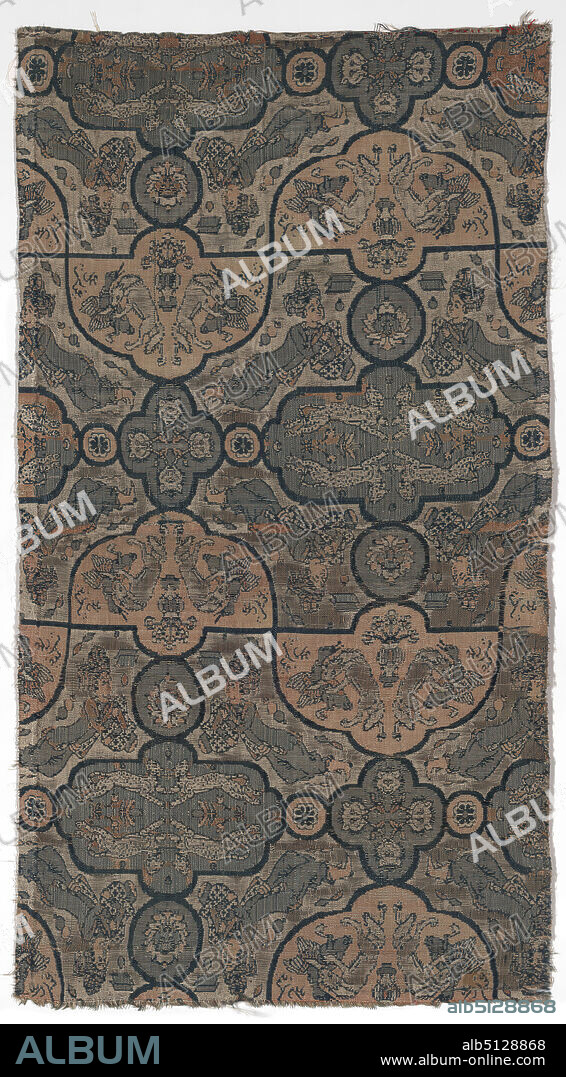alb5128868
Maker: Khwaja Ghiyath ad-din Ali, active late 16thearly 17th century, Textile Fragment with Figures, Animals, and Plants, late 16thearly 17th century, Triple-weave silk, 8 7/8 × 16 5/16 in. (22.6 × 41.5 cm), Poet, painter, mystic, and master weaver of the court of Shah Abbas, Khwaja Ghiyath ad-din Ali is the most famous of the Safavid designers whose textiles bear their signatures. Scholars first noticed his name on a small number of silks early this century, and since then, his fabrics have emerged as some of the finest Persian textiles ever made. Here, Khwaja Ghiyaths rendering of the figural elements enclosed in the patterns compartments betray his predilection for miniature painting. Reclining gentlemen, fox attacking geese, confronting cheetahs, lions heads, and assorted plant forms are typical of the elements that made up the personage textile patterns so popular during Ghiyaths time. In this design, however, Ghiyath has ingeniously arranged the motifs within a nonpictorial space. The use of curvilinear compartments is unusual in lightweight silks of this kind, and may have been taken from carpets of the period., Iranian/Persian, Islamic, Safavid dynasty (15011722), Textiles.

|
Add to another lightbox |
|
Add to another lightbox |



Caption:
Maker: Khwaja Ghiyath ad-din Ali, active late 16thearly 17th century, Textile Fragment with Figures, Animals, and Plants, late 16thearly 17th century, Triple-weave silk, 8 7/8 × 16 5/16 in. (22.6 × 41.5 cm), Poet, painter, mystic, and master weaver of the court of Shah Abbas, Khwaja Ghiyath ad-din Ali is the most famous of the Safavid designers whose textiles bear their signatures. Scholars first noticed his name on a small number of silks early this century, and since then, his fabrics have emerged as some of the finest Persian textiles ever made. Here, Khwaja Ghiyaths rendering of the figural elements enclosed in the patterns compartments betray his predilection for miniature painting. Reclining gentlemen, fox attacking geese, confronting cheetahs, lions heads, and assorted plant forms are typical of the elements that made up the personage textile patterns so popular during Ghiyaths time. In this design, however, Ghiyath has ingeniously arranged the motifs within a nonpictorial space. The use of curvilinear compartments is unusual in lightweight silks of this kind, and may have been taken from carpets of the period., Iranian/Persian, Islamic, Safavid dynasty (15011722), Textiles
Credit:
Album / quintlox
Releases:
Model: No - Property: No
Rights questions?
Rights questions?
Image size:
2759 x 4992 px | 39.4 MB
Print size:
23.4 x 42.3 cm | 9.2 x 16.6 in (300 dpi)
Keywords:
15011722 • ACTIVE LATE 16THEARLY 17TH CENTURY • AND ASSORTED PLANT FORMS • AND MASTER WEAVER • AND • AND PLANTS • ANIMAL • ANIMALS • CARPETS • CELEBRITY • CENTURY • CONFRONTING CHEETAHS • COURT, THE • CURVILINEAR COMPARTMENTS • DESIGN • ELEMENTS, THE • EMERGED • FABRICS • FAMOUS • FIGURAL ELEMENTS ENCLOSED, THE • FIGURES • FINEST PERSIAN TEXTILES, THE • FOX ATTACKING GEESE • GHIYATH • GHIYATHS TIME. • INGENIOUSLY ARRANGED • IRANIAN / PERSIAN • ISLAMIC • KHWAJA GHIYATH AD-DIN ALI • KHWAJA GHIYATHS RENDERING • KIND • LATE 16THEARLY 17TH CENTURY • LIGHTWEIGHT SILKS • LIONS HEADS • MAKER • MINIATURE PAINTING. RECLINING GENTLEMEN • MOTIFS WITHIN • MYSTIC • NAME • NONPICTORIAL SPACE. • PAINTER • PATTERNS COMPARTMENTS BETRAY, THE • PERSONAGE TEXTILE PATTERNS • POET • POPULAR • PREDILECTION • SAFAVID DESIGNERS, THE • SAFAVID DYNASTY • SHAH ABBAS • SIGNATURES. SCHOLARS FIRST NOTICED • SILKS EARLY • SMALL NUMBER • TEXTILE FRAGMENT • TEXTILES BEAR • TEXTILES • THE PERIOD. • TRIPLE-WEAVE SILK • TYPICAL • UNUSUAL • UP
 Pinterest
Pinterest Twitter
Twitter Facebook
Facebook Copy link
Copy link Email
Email

